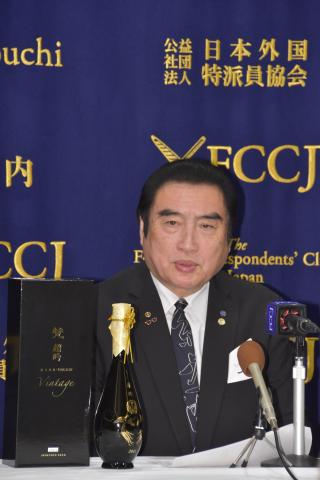Issue:
October 2024
Declining demand at home has forced Japan’s sake breweries to look to the luxury overseas market

The award-winning sake label Born Sake brought its most exclusive offering yet to the FCCJ last month: Daiginjo Vintage, a 720 ml bottle of which will set you back ¥1 million.
Born Sake’s owner and FCCJ member Atsuhide Kato proudly displayed the new label in its opulent silk tasseled ink-blue bottle adorned with two lacquer-painted gold phoenixes. “Even the box containing the bottle is made from Japanese washi,” said Kato the 11th-generation head of Kato Kichibei brewery in Fukui Prefecture. “We’re targeting the global rich … they expect the best.”
Kato’s focus on the luxury market reflects a desire among Japanese sake brewers to establish a footing in overseas markets on a par with European winemakers and Scottish and Japanese whisky distillers.
The contenders include Dassai, produced by Asahi Shuzo, which has brewed sake in Yamanashi Prefecture since 1948. Like Born, Dassai, meaning “celebration of life”, has won a slew of international awards.
According to Leopold Puziella, Dassai’s international brand advocacy manager, the company exports 60% of the 6 million bottles it produces every year, mainly to Europe, the U.S., and countries in Asia.

“We are also planning to target untapped segments by expanding our experimental range of top-class sake,” he said. “The essence of Dassai's success is its relentless creativity.”
Dassai’s range include Ambition Sake, just 120 bottles of which are produced annually. “The attraction for imbibers is its uniqueness,” Puziella said. Despite the high price of some of its special labels, the brewery’s focus is not on the bottom line but on creating unique sake, he added.
Kenjiro Monji, a former Japanese ambassador to UNESCO, said foreign markets were critical to countering the long-term decline in sake consumption in Japan.
Changes in the Japanese diet have seen wine consumption taking over sake, especially among young people,” Monji said. As a result, more Japanese brewers are producing diverse, high-quality sake – an approach that has driven exports up every year for more than a decade, helped by the global washoku boom.
Japan’s government is pushing for sake, known in Japan as nihonshu, to be listed as a UNESCO Intangible Cultural Heritage, more than a decade after washoku received the accolade.
The government sponsors sake promotion events abroad, including those that pair the drink with cuisines from around the world. Kato often attends official functions for visiting foreign dignitaries – opportunities for his brewery’s sake to break the ice.
Production, too, is moving overseas, with breweries popping up in countries such as the U.S., France and Britain, some of which collaborate with Japanese firms.
“Sake making is an extremely complex craft,” Monji said, referring to essential elements such as the quality of local groundwater and rice, as well as rice polishing and fermentation techniques that have been passed down through the generations.
Born’s Daiginjo Vintage is made with high-quality rice produced by specially contracted farmers. Unusually for sake, it is aged for 10 years at a constant 15C, with production confined to just 200 bottles a year.
So, what is it like? I was fortunate enough to taste it, courtesy of Kato, who poured a modest measure into a large wine glass. The liquid was crystal clear and had a slight aroma of lychees. “This is like a dream come true,” Kato said as he a clinked glasses and let out a hearty “Kampai!”
Suvendrini Kakuchi is Tokyo Correspondent for University World News in the UK.

